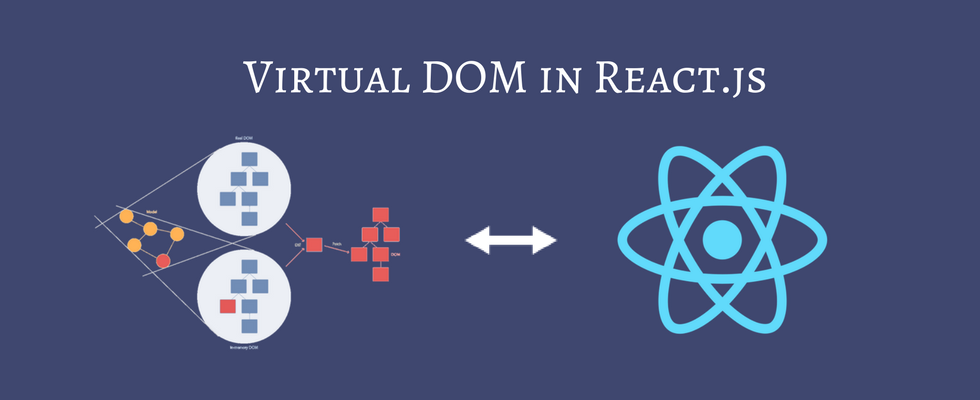React, a JavaScript library has been among the most demanded web development tools since the moment of its initial release in 2013. The library’s popularity is based mostly on its founder company’s status (Facebook) and the extraordinary capabilities it provides developers. Let’s go a bit deeper into the topic and examine why React is so popular.
React: Brief Overview
As we’ve already mentioned, React is a JS library introduced by Facebook developers. Juxtaposed with the Angular framework, which is based on MVC architecture, React is helpful when using View components, providing flexibility for developers. Coding with React results in HTML code.
Using React is, basically, an interpretation of reactive programming — i.e., the changing of the working principles of a software solution depends on the changing state of its components. Reactjs constantly involves DOM based on the JS code and redraws its separate nodes when needed, doing so faster than any other previously existing solutions.
To work with React, you will need JSX, a preconfiguration in JavaScript that allows the use of XML in the JavaScript code. This, basically, adds a couple of additional specifications to the syntax and doesn’t affect the overall complexity of the project.

Why do Companies Increasingly Choose React?
Let’s see why React is better than any other library or framework for frontend development as well as how to indicate the value of its advantages in the project life cycle to the fullest extent:
- Simple to figure out. A steep learning curve is an initial factor in favor of the question - why choose React? In particular, according to statements of most developers (including some of our own in-house specialists), it isn’t difficult to figure out React if you have some skills in HTML and JavaScript. On top of everything else, as opposed to many other frameworks, this library doesn’t contain any special rules and excessive code constructions, which is a common ‘sin’ in Angular, for one thing. That means that you don’t need to waste loads of time on code optimization and figuring out the objects’ structure.
- Modular nature. The React library was initially created for building web solutions based on the components that are gradually surrounded by more complex structures. This approach allows developers to form separate module blocks that, further on, could be very easily modernized and used in other projects. Moreover, it provides a wholesome representation of the whole project, i.e., all connections between separate components are defined along their development, not at the beginning or finish of working on the project (which can be quite cumbersome when there is a large number of separate files and classes to deal with).
- Simplicity of code testing. The module nature of code not only significantly increases the speed of development. Reusing the existing code allows for avoiding plenty of errors in new projects. If you repeatedly use initially efficiently designed components, you’ll need to write less code and just use them to build a new user interface. The less new code you need, the lesser the chances of new errors appearing. You’ve already gone through them and tested everything while working with a real project, which means that when bugs appear in the code, it’ll be easier to define their origins.
- Simplicity of code optimization. A component-oriented approach to the creation of React-based solutions provides developers with the ability to easily customize the existing components, turning the software development process into a constant enhancement process. The components that were already created during some other project's life cycle don’t have additional dependencies. In this sense, nothing gets in the way of using them again for other projects, gradually optimizing them according to the changing client requirements and implicit UX requirements.
- Propensity for creating dynamic web pages. The creation of interactive elements and dynamic content is the forte of the library in a discussion. The thing is: standard tools and technologies, like the JS + HTML + CSS combination, don’t allow for creating something interactive and dynamic without sacrificing performance. For instance, the visual part of the HTML code, called DOM (Document Object Model - a tree of objects), is usually redrawn each time a user makes certain changes within the page (e.g. scrolls it down). The redrawing operation is quite resource-intensive if it isn’t optimized the right way. In the case of ReactJS, instead of regular DOM, its lightweight copy—Virtual DOM—is used. It doesn’t redraw the whole tree from scratch, only the nodes that were changed. As a result, from the user's perspective, we get an almost immediate reaction to any manipulations.

- Ability to create isomorphic apps. This ability literally means that you can use the same code base both on the server and the client side. For instance, upon the initial launch of a web page by a user in the browser, the browser downloads the minimum extent of an HTML page while the content is filled with the help of the JavaScript code. In a range of cases, e.g. with a bad Internet connection, this can be a pretty resource-intensive procedure (and, possibly, exceed the notorious normal UX speed curve of 2 seconds). In turn, transferring a part of the JS code to the server side, i.e. implementation of rendering on the server, can help solve this issue and handle some problems with SEO (by making indexation of web pages in Google, Yahoo, Bing, and other search engines much smoother). The particular case of implementing this approach is the headless website structure that, on top of the React library (used for frontend), also involved Drupal 8 (for backend).
- No need for detalization of objects. Yet another good thing about ReactJS is the level of abstraction the library provides. It allows you to forget about dedicating any extra efforts to the creation of objects, defining properties that matter least in them. In this aspect, in terms of accessibility and speed of performance, ReactJS outruns Angular—which is rightfully deemed as one of the most popular frameworks for frontend development.
- A wide range of compatible tools. React is an extensively popular library, which is why it is compatible with numerous third-party tools. Thus, in your projects, you can limitlessly employ React Developer Tools, Bootstrap, Drupal, or Redux.
- Steep learning curve in terms of developing cross-platform mobile software. If you decide to grow in your developer career, ReactJS will come in handy. For example, you can go for another Facebook project—React Native—a solution created with the motto 'Write once, run anywhere.' Basically, this framework allows the creation of mobile apps by employing the skills acquired when learning how to work with React. The app logic will be written in JavaScript. In this sense, a programmer doesn’t have to refuse common web development techniques. It is then simply necessary to figure out how to write the code specific to certain devices that also adapt previously created components to the new environment.
- Top status on the market. Did you know that React laid the foundation for the development of such web solutions as Dropbox, Netflix, Airbnb, PayPal, Walmart, Tesla Motors, and others? Not to mention Facebook itself. We believe that this is a great indication of the library being literally crammed with top solutions for up-to-date web development.
- Large developers community. Last but not least, to answer the question ‘Why use React for web development at all?’ It is really popular, which means that there are tons of tutorials, public pages, and articles dedicated to web development based on ReactJS. Visit any of the ReactJS developer forums to immediately get the answer to practically any question.
Read also: 10 Famous Websites Built with ReactJS
Why Use ReactJS: Summary
Having analyzed all the above-mentioned reasons to use ReactJS for web development, you’ll agree with us that the library is easily among the best tools for all web developers out there. Indeed, React is so accessible in use and so flexible in performance that it becomes hard to overestimate all the benefits that website and app creators receive from it. You can also experience the great powers of React. Contact us and order a ReactJS-based project. We’ll provide you with a user experience that will propel your concept to the forefront of the industry.
